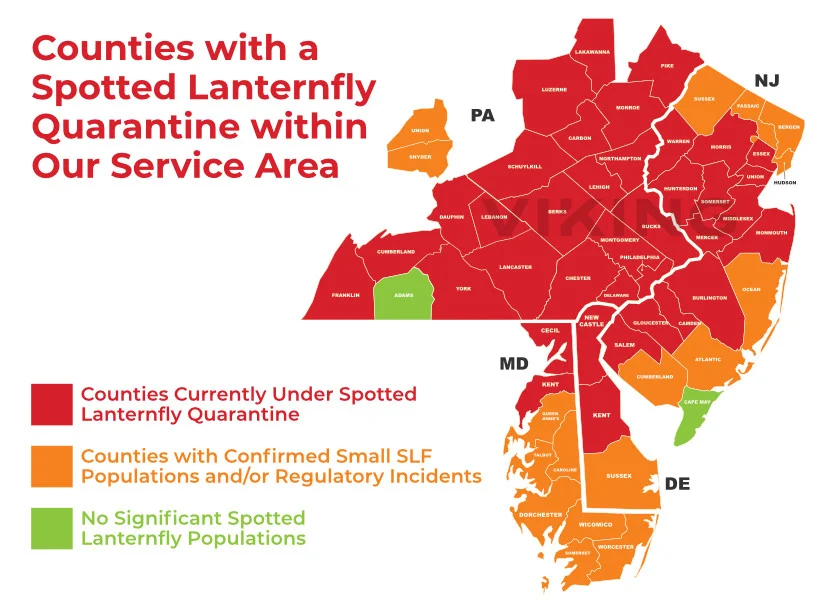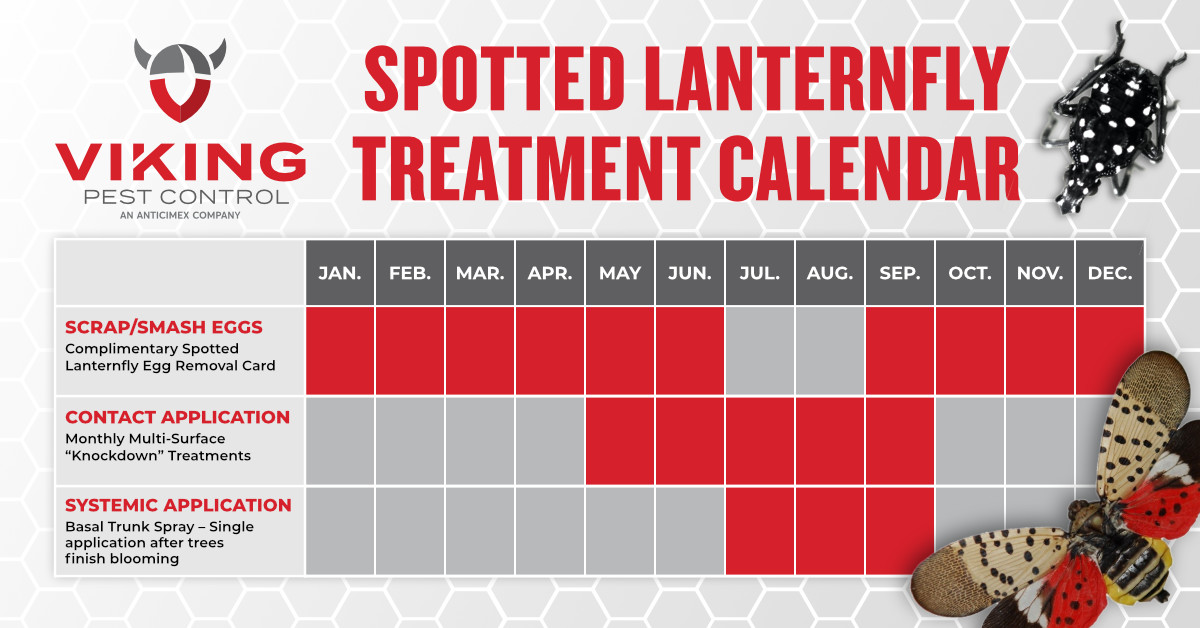Spotted Lanternfly Treatment & Prevention

Viking Pest provides treatments for Spotted Lanternflies in Pennsylvania, New Jersey, Delaware, and Eastern Shore of Maryland. Viking’s spotted lanternfly treatment is specifically formulated not to harm non-target wildlife like squirrels and birds. Please contact us for more information about our spotted lanternfly service plan to see what is available in your area.
What Is A Spotted Lanternfly?
The spotted lanternfly has the potential to be a devastating invasive species wherever it goes. To date, the spotted lanternfly population has required many counties throughout several states to implement a quarantine to reduce the spread of these insects. They can feed on most plant species and affect businesses like vineyards, timber, and other types of farms. The spotted lanternfly is known to cause economic and property damage unsurpassed by native pest species. Because spotted lanternfly damage can be extensive, it is suggested that a professional pest control company be contacted at first sight.
The spotted lanternfly was first discovered in Pennsylvania in 2014. They are believed to have been introduced from South East Asia around 2012. Since 2014, they have spread to more than seven states including New Jersey, Delaware, and Maryland.
Spotted lanternflies are plant parasites and have been observed feeding on more than 70 species of plant. Among their favorites are tree-of-heaven, grapes, hops, hardwood trees, and fruit trees. It is also believed they can spread plant diseases. Due to the large numbers often feeding at once, they can greatly weaken a tree or plant. This may cause slow growth and, in some circumstances, may even lead to the death of the plant. This can be catastrophic for many industries including forestry, viniculture, orchards, and landscaping.
Click to Enlarge
How to Spot Spotted Lanternfly Damage?
When feeding, they expel a sweet sticky substance called honeydew. This substance often attracts ants and stinging insects in large numbers. The honeydew expulsion can be so high that it covers all surfaces beneath. Not only can this be unsightly and difficult to clean, but it also may support sooty mold growth. In some severe infestations during periods of warm weather, so much honeydew may be excreted that it appears to be raining from the tree above.
What Do Spotted Lanternflies Eat?
 Spotted lanternflies feed on the sap of plants. There are currently over 70 identified plant species they feed on. These include agricultural crops such as hops and grapevines, as well as ornamental plants. The tree-of-heaven is a particular favorite of the spotted lanternfly.
Spotted lanternflies feed on the sap of plants. There are currently over 70 identified plant species they feed on. These include agricultural crops such as hops and grapevines, as well as ornamental plants. The tree-of-heaven is a particular favorite of the spotted lanternfly.
How Long do Spotted Lanternflies Live?
Females lay eggs beginning in September. These spotted lanternfly egg masses are deposited in rows and then covered with excretion to better protect the eggs. This stage is potentially the most important for pest control specialists to manage. It is easier to kill eggs than the nymph spotted lanternflies that hatch. Each mass of eggs contains 30-50 young. Females can create 2-3 such egg masses in her lifetime. Sometimes eggs are not covered and left exposed. The covering will dry out and crack over time.
Spotted lanternfly eggs can be laid on almost any surface. This is the only stage of a spotted lanternfly’s life cycle that survives the winter. At Viking Pest, we eliminate spotted lanternfly eggs (in New Jersey, Pennsylvania, Delaware, and Maryland) from May to October. The good news is, only one generation per year occurs in this region. If we can control the egg population, we can mitigate the spotted lanternfly damage.
Once the lanternfly eggs hatch, they are into the second main stage of their life. This is the nymph or instar stage. There are four sub-stages within this portion of their life. During the first stage, they feed at a rapid pace. Their appearance also changes from only black with white spots to black with white spots and red patches towards adulthood.
All life stages feed exclusively on plants. They are not capable of biting or stinging, therefore pose no risk to people or pets. Juvenile-aged spotted lanternflies move quite quickly but cannot fly. Adults can readily fly and are excellent hitchhikers. All spotted lanternfly life stages are easily transported to an un-infested area, but eggs pose the biggest risk for spreading this pest. Therefore, it is important to control them at as early a stage as possible to prevent the spread of spotted lanternfly damage.
How to Identify a Spotted Lanternfly?
There are four juvenile spotted lanternfly stages before adulthood. The juveniles look very different from the adults. Juveniles are black with white dots early in their development and are about 1/4” in length. As the juveniles grow, they become red and black with white dots and are approximately ½” long. Adults are mauve and rest with their wing held above their back. When the adults become excited, they open their wings and reveal a bright red coloration beneath their wings. This bright red makes it easy to identify the spotted lanternfly.
If you believe you have spotted lanternflies, we recommend obtaining one or more samples and place them in a vial with alcohol. This will allow the team at Viking Pest, to properly identify the insect in question.
How to Get Rid of Spotted Lanternflies
Everyone can contribute to the fight against spotted lanternflies. If you encounter a spotted lanternfly you should stomp on it.
While many controlled pest control products will stop this pest on contact, residual control is difficult to achieve. Spotted lanternflies can breed in such large numbers that they will repopulate in just a couple of days which requires reapplication. Therefore, it is not recommended to utilize most over-the-counter products to control this pest. Spotted lanternfly populations in New Jersey, Pennsylvania, Delaware, and Maryland should be addressed by professional pest control companies like Viking Pest.
Spotted Lanternfly Control and Prevention for Businesses
Viking Pest offers specialized spotted lanternfly treatments for commercial properties. Spotted Lanternflies have the potential to damage orchards, vineyards, and overall can weaken the trees on properties creating an unsafe atmosphere for valued customers. The Viking team consists of professionally trained and licensed Spotted Lanternfly experts that will perform an in-depth inspection of your property and create a spotted lanternfly control program specifically for your commercial property.
How Do You Protect Your Home or Business From Spotted Lanternflies?
Viking offers a service plan which consists of two different methods to residents of NJ, PA, DE, and MD. The first is a knockdown service which consists of a monthly application of an EPA-approved material to trees and manmade surfaces for quick and efficient population reduction. The second is a basal tree treatment performed once per year where allowed by law to kill spotted lanternflies when they feed. These services are skillfully applied by highly trained and licensed pest management professionals to maximize effectiveness while minimizing risk to the environment.
What is Basal Trunk Spray?
Basal trunk spraying is a powerful and effective means of exterminating spotted lanternflies where allowed by law. Around the beginning of July, after the trees have completed their flowering, Viking technicians apply a specially formulated treatment to the base of trees. The product is then absorbed into the tree and is ingested by the spotted lanternfly when it feeds. Once applied, the treatment will not harm the tree nor any other vegetation and will act as a natural barrier helping protect the tree from Spotted Lanternflies. In a matter of days, the liquid will be absorbed into the roots and trunk, helping protect the tree from the inside out.
Does Viking Offer Spotted Lanternfly Treatments for Other Surfaces?
Yes, Viking Pest offers a liquid treatment for other surfaces. This knockdown treat
ment is designed to treat outdoor surfaces such as wood, shrubs, foundations of buildings, surfaces of buildings, porches, screens, window frames, eaves, patios, garages, refuse dumps, and other similar areas where these pests are active. This treatment cannot guarantee Spotted Lanternflies from returning, but it can help take the first step in controlling the population.
Choose Viking Pest for Spotted Lanternfly Control and Prevention
Viking Pest offers a specialized treatment specifically for spotted lanternflies. Viking Pest can provide Spotted Lanternfly knockdown services and liquid treatments in Pennsylvania, New Jersey, Delaware, and Maryland. Viking’s spotted lanternfly treatment is specially formulated to prevent harming non-target wildlife like squirrels and birds. Please contact us for more information about our spotted lanternfly service plan and to see what is available in your area.
Various home remedies can be found on the world wide web, but we do not recommend them for controlling the spotted lanternfly. Some seemingly harmless home remedies can be quite dangerous to you and the environment. The following link from Penn State explains in more detail why home remedies are best avoided. Viking Pest knows how to get rid of spotted lanternflies. Call today for your FREE and NO OBLIGATION estimate at 800-618-2847 or schedule online today!















